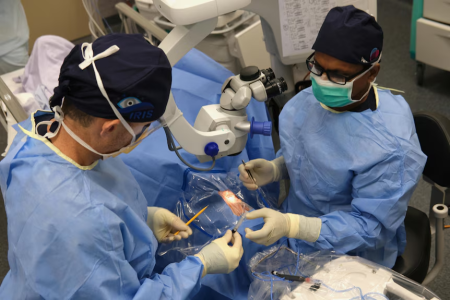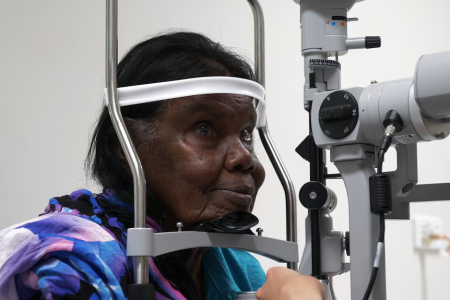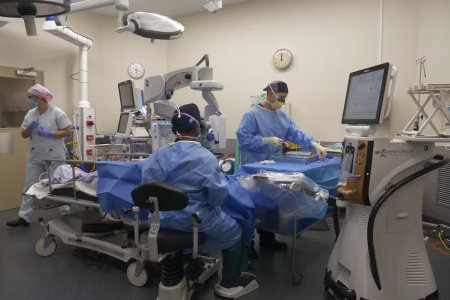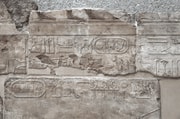Cataract surgery blitz for Indigenous patients restores sight for hunting
By
ABC News
- Replies 7
In the operating theatre at Katherine Hospital, the team moves in silent unison.
Scrub nurse Peter Mitchell anticipates which tool the surgeon will need next, as he carefully makes a small incision in a patient's eye.
"Being in theatre in this situation, it's a really beautiful feeling — a real sense of flow and understanding," he says.
But these are tricky cases.
The patient on the table has a dense cataract that has gone untreated for some time.
"Very, very seldom do you see a cataract as hard as this down south, but they're relatively common in the sorts of areas we're in now," Mr Mitchell says.
Patients have been flown and driven into Katherine from remote communities across the Big Rivers region of the Northern Territory for an intensive week of surgeries, conducted by the Indigenous and Remote Eye Service.
Over two days, cataracts will be removed from 27 eyes, in some cases bringing patients back from the brink of blindness.
She had been struggling with hunting and fishing, with her vision in one eye obscured by cloudy cataracts.
"When I go hunting … nice eye I can look, other one no good," she says.
Now, after her surgery, she's able to read some of the smallest letters on the eye test chart.
And she's looking forward to putting her new vision to the test back home.
"It's good. We'll go fishing … get barramundi, long ones, and turtles."
The eye doctors say while patients in Sydney and Melbourne will sometimes joke that they can now see their wrinkles more clearly, it's common for Indigenous patients in the Top End to talk about things like hunting.
"It's always exciting to see the patients smiling when we remove the patch over the eye," surgeon Susith Kulasekara says.
"There are so many ways it can improve the patient's quality of life. Often driving, the patients say … and caring for their family."
Director of primary health care in the Big Rivers region, Antony King, says cataract surgeries are "immediately rewarding" for patients and staff at the hospital.
"It's not something that's seen often," he says.
As the clouding of the lens in the eye progresses gradually, often affecting both eyes, many remote patients don't realise how bad their vision has become until they get a visit from a travelling optometrist.
And then there are all the challenges of traversing hundreds of kilometres for a surgery, on poor-quality roads that often close during the wet season.
Health workforce data shows 1,004 ophthalmologists practising in Australia as of 2023, with only seven of those in the vast Northern Territory.
The Indigenous and Remote Eye Service, known as IRIS, is a federally funded program bringing eye surgeons to the outback to tackle the backlog of cases.
"The distribution of the clinicians that are needed to deliver these services has contracted in Australia … over a number of decades," Tim Gallagher, chief executive of Brisbane-based Vanguard Health, which delivers the program, says.
Mr Gallagher says patients will sometimes be on the waiting list for two to three years before they can be seen.
Getting dozens of remote residents to the hospital on one day is an enormous logistical challenge, especially when some people don't use mobile phones and move from place to place.
The program has succeeded by performing more than 800 cataract surgeries since mid-2023. It will now attempt to complete a further 800 during the next two years.
Dr Kulasekara says word spreads about how straightforward and painless the procedure is when patients return to their community.
"They become ambassadors," he says.
He says the transformation of his vision after having cataracts removed from both eyes has been astonishing.
"I just couldn't believe how bright everything was, the colours," he says.
Mr Wilson says he does most of the vacuuming around his house but was increasingly missing spots.
"I'll be told by my wife, 'That's still a bit dirty, can't you see that?'" he laughs.
"So that is the sort of thing that I think will make a difference. I won't miss bits."
As fellow patient Mildred Hector leaves to catch her plane back to her community of Nitjpurru, she grabs one of the eye doctors for a parting hug.
"Thank you my dear, enjoy your vision," the doctor says.
By James Elton
Scrub nurse Peter Mitchell anticipates which tool the surgeon will need next, as he carefully makes a small incision in a patient's eye.
"Being in theatre in this situation, it's a really beautiful feeling — a real sense of flow and understanding," he says.
But these are tricky cases.
The patient on the table has a dense cataract that has gone untreated for some time.
"Very, very seldom do you see a cataract as hard as this down south, but they're relatively common in the sorts of areas we're in now," Mr Mitchell says.
Patients have been flown and driven into Katherine from remote communities across the Big Rivers region of the Northern Territory for an intensive week of surgeries, conducted by the Indigenous and Remote Eye Service.
Over two days, cataracts will be removed from 27 eyes, in some cases bringing patients back from the brink of blindness.
Clear eyes, good hunting
One of the patients is Mildred Hector, a Bilinarra woman from Nitjpurru, formerly known as Pigeon Hole.She had been struggling with hunting and fishing, with her vision in one eye obscured by cloudy cataracts.
"When I go hunting … nice eye I can look, other one no good," she says.
Her friends had noticed she sometimes had trouble seeing them too.Now, after her surgery, she's able to read some of the smallest letters on the eye test chart.
And she's looking forward to putting her new vision to the test back home.
The eye doctors say while patients in Sydney and Melbourne will sometimes joke that they can now see their wrinkles more clearly, it's common for Indigenous patients in the Top End to talk about things like hunting.
"It's always exciting to see the patients smiling when we remove the patch over the eye," surgeon Susith Kulasekara says.
"There are so many ways it can improve the patient's quality of life. Often driving, the patients say … and caring for their family."
Director of primary health care in the Big Rivers region, Antony King, says cataract surgeries are "immediately rewarding" for patients and staff at the hospital.
"It's not something that's seen often," he says.
Cataract gap
Cataracts are the leading cause of blindness for Indigenous adults and are responsible for a sizeable chunk of the eye health gap.As the clouding of the lens in the eye progresses gradually, often affecting both eyes, many remote patients don't realise how bad their vision has become until they get a visit from a travelling optometrist.
And then there are all the challenges of traversing hundreds of kilometres for a surgery, on poor-quality roads that often close during the wet season.
Health workforce data shows 1,004 ophthalmologists practising in Australia as of 2023, with only seven of those in the vast Northern Territory.
The Indigenous and Remote Eye Service, known as IRIS, is a federally funded program bringing eye surgeons to the outback to tackle the backlog of cases.
"The distribution of the clinicians that are needed to deliver these services has contracted in Australia … over a number of decades," Tim Gallagher, chief executive of Brisbane-based Vanguard Health, which delivers the program, says.
Getting dozens of remote residents to the hospital on one day is an enormous logistical challenge, especially when some people don't use mobile phones and move from place to place.
The program has succeeded by performing more than 800 cataract surgeries since mid-2023. It will now attempt to complete a further 800 during the next two years.
Dr Kulasekara says word spreads about how straightforward and painless the procedure is when patients return to their community.
"They become ambassadors," he says.
Colour returns
While most of the IRIS patients are Aboriginal, some are not, such as 83-year-old Katherine resident Peter Wilson.He says the transformation of his vision after having cataracts removed from both eyes has been astonishing.
"I just couldn't believe how bright everything was, the colours," he says.
Mr Wilson says he does most of the vacuuming around his house but was increasingly missing spots.
"I'll be told by my wife, 'That's still a bit dirty, can't you see that?'" he laughs.
"So that is the sort of thing that I think will make a difference. I won't miss bits."
As fellow patient Mildred Hector leaves to catch her plane back to her community of Nitjpurru, she grabs one of the eye doctors for a parting hug.
"Thank you my dear, enjoy your vision," the doctor says.
By James Elton










